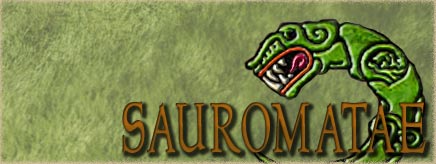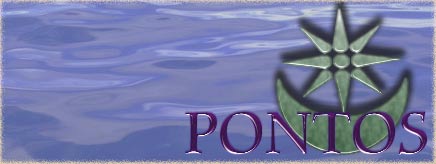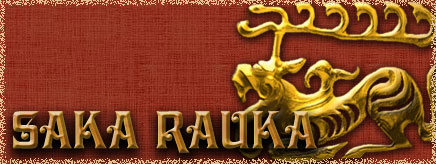
Originally Posted by
athanaric
Dahyu Mazsakata
Overview:
(1.215.1) “These Massagetae are like the Scythians in their dress and way of life. They are both cavalry and infantry (having some of each kind), and spearmen and archers; and it is their custom to carry battle-axes. They always use gold and bronze; all their spear-points and arrow-heads and battle-axes are bronze and the adornment of their headgear and belts and girdles is gold.
[2] They equip their horses similarly, protecting their chests with bronze breastplates and putting gold on reins, bits, and cheekplates. But they never use iron and silver, for there is none at all in their country, but gold and bronze abound.
(1.216.1) Now for their customs: each man marries a wife, but the wives are common to all. The Greeks say this is a Scythian custom; it is not, but a custom of the Massagetae. There, when a man desires a woman, he hangs his quiver before her wagon, and has intercourse with her without fear.
[2] Though they fix no certain term to life, yet when a man is very old all his family meet together and kill him, with beasts of the flock besides, then boil the flesh and feast on it.
[3] This is held to be the happiest death; when a man dies of an illness, they do not eat him, but bury him in the earth, and lament that he did not live to be killed. They never plant seed; their fare is their livestock and the fish which they take in abundance from the Araxes.
[4] Their drink is milk. The sun is the only god whom they worship; they sacrifice horses to him; the reasoning is that he is the swiftest of the gods, and therefore they give him the swiftest of mortal things.“
Herodotos: The Histories. Book I, Chapters 215-216.
Geography:
The geographer Strabon writes:
“Statements to the following effect are made concerning the Massagetae: that some of them inhabit mountains, some plains, others marshes which are formed by the rivers, and others the islands in the marshes. But the country is inundated most of all, they say, by the Araxes River, which splits into numerous branches and empties by its other mouths into the other sea on the north, though by one single mouth it reaches the Hyrcanian Gulf. […] Silver is not found in their country, and only a little iron, but brass and gold in abundance. (Strabo: Geographika, XI/8/6)”
This region encompasses the plains between the Syr Darya, the Aral lake and the Amu Darya. This is a harsh, arid land, with hot summers, cold winters, and a dry climate. It is mostly flat and dominated by steppe vegetation and semi-deserts. The riverbanks and the shores of the great lake allow for fishing and agriculture.
As for wildlife, there are various sorts of game, especially Saiga antelopes and wild sheep and horses as well as bustards. Even large predators such as the Caspian Tiger would occur in the wetlands. Eagles patrol the skies and, once captured and trained, are cherished hunting companions for the steppe peoples.
History:
Of old, these lands were populated by Iranian peoples of nomadic and pastoral tendencies. They are called “Saka” by Eastern sources and “Skythian” by the Greek. Ethnically, these would have been mainly Iranian, possibly with an admixture of Mongoloid population from the eastern parts of Central Asia.
The eponymous Massagetae tribe rose to some literary prominence among its civilized contemporaries. According to legend, it was the Massagetae queen Tomyris whose army slew the famous King Kyros II “the Great” of Persia, when he tried to conquer her people.
The Massagetae appear to have been a semi-nomadic people, who, besides cattle herding, also relied on other sources of sustenance. According to our source, “they never plant seed; their fare is their livestock and the fish which they take in abundance from the Araxes. [4] Their drink is milk.” (Herodotos, I.216). Another source is a little more informative:
“Now those who live in the islands, since they have no grain to sow, use roots and wild fruits as food, and they clothe themselves with the bark of trees (for they have no cattle either), and they drink the juice squeezed out of the fruit of the trees. Those who live in the marshes eat fish, and clothe themselves in the skins of the seals that run up thither from the sea. The mountaineers themselves also live on wild fruits; but they have sheep also, though only a few, and therefore they do not butcher them, sparing them for their wool and milk; and they variegate the color of their clothing by staining it with dyes whose colors do not easily fade. The inhabitants of the plains, although they possess land, do not till it, but in the nomadic or Scythian fashion live on sheep and fish. Indeed, there not only is a certain mode of life common to all such peoples, of which I often speak, but their burials, customs, and their way of living as a whole, are alike, that is, they are self-assertive, uncouth, wild, and warlike, but, in their business dealings, straightforward and not given to deceit.(Strabo XI.8.7)” Strabo also differentiates between Saka and Massagetae.
Archaeological finds attest to a development of a class society, with prominent burial mounds called Kurgans erected for important leaders. The political organisation of the Massagetae seems to have been monarchy. Slavery was widespread and common but developed somewhat differently from slavery tradition in Mediterranean cultures. Women are said to have held a relatively high position compared to Mediterranean cultures. However, as one source puts it, “it is not clear whether a parallel can be drawn between Saka-Massagetian society and its western neighbour, the matrilineal Sarmatian society.”1 Also, they were reported to share their wives amongst each other and to eat their dead. However, this may be a conflation of actual facts and Greek imagination.
Like other Skythians, the Massagetae were known for goldwork, usually depicting mythological elements and scenes, especially griffins.
Of their religion, it is said that “The sun is the only god whom they worship; they sacrifice horses to him; the reasoning is that he is the swiftest of the gods, and therefore they give him the swiftest of mortal things.“ ( Herodotos, I.216)” - which also reflects the increasing importance of the horse in those parts, which was another factor in the transition from a culture of Pastoralist cattle herders to a culture of true nomads.
Accordingly, cavalry became increasingly important. It has been indicated that the Massagetae were the ones who first developed horse armour, thus instigating the development of the fully armoured cavalry that was the pride of ancient Iranian and Medieval European knighthood. This is hinted at even in Herodot's description of their martial traditions. Similarly, Strabo writes: “They are good horsemen and foot-soldiers; they use bows, short swords, breastplates, and sagares made of brass; and in their battles they wear headbands and belts made of gold.“
In these parts of Central Asia, there appears to have been some form of coexistence between the nomadic Saka (or, in this particular case, Massagetae), and the sedentary farmers who settled the oases. The Skythians, much like their various successors, were of great importance to trade between East Asia on one side and Europe, the Near East, and India on the other. It was in their own economic interest to keep open extensive trade routes that connected China with Persia, so as to profit from the revenue. Especially Bukhara, the region capital, was to become an important hub of trade and cultural innovation. Even after the Turkic invasions, Sogdian traders played an important role in the Silk Road business.
It has been said that the Massagetae were the forefathers of the Alans, who in turn not only were the ancestors of the Ossetian people, but also greatly influenced Later Sarmatian culture and left their traces all over Europe during the Migration period, reaching as far as Spain and North Africa. Medieval Persian historian Al-Biruni claims that the Alans originally dwelt at the lower Amu Darya. Also, several place names containing the name “Alan” are known from Central Asia, according to V. Kousnetsov and Y. Lebedynsky, and “It is likely that the Sako-Massagetae tribes played an important role in the ethnogenesis of the new, very mixed Turkic-language peoples in Western Central Asia (…).”
Strategy:
Any conqueror of this territory will find themselves faced with stern opposition and an unforgiving continental climate, which, along with the open nature of the land, make it a daunting task to control the region. This province has the typical benefits and drawbacks of a steppe region; it will not offer many resources to sedentary factions. However, powerful and efficient nomadic cavalry troops may be available as auxiliaries. Nomadic factions should focus on developing trade routes and keeping an eye open for unwelcome visitors.
Originally Posted by athanaric
Dahyu Mazsakata









 Reply With Quote
Reply With Quote
Bookmarks